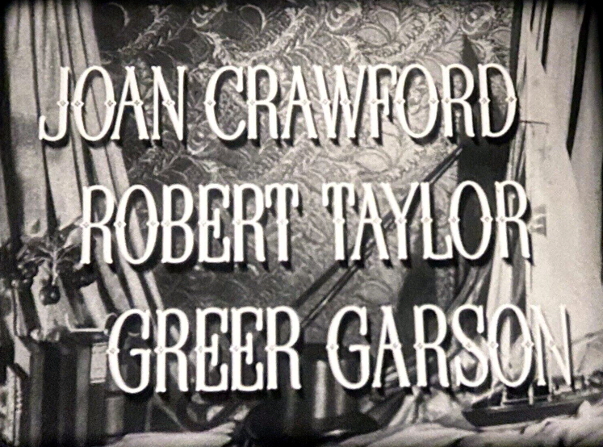
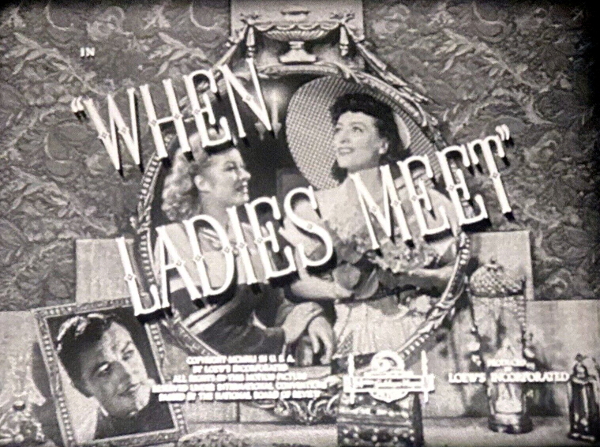
The Best of Everything
Encyclopedia Entry • Films Main
When Ladies Meet
1941


Critics' Reviews • Our Reviews • Movie Posters • Lobby Cards • Misc. Images
Click here to see photos from the film.
US theatrical release: 8/29/41.
VHS release: 6/24/92. Warner Archive DVD release: 3/23/09. Cast: Joan Crawford (as "Mary Howard"), Robert Taylor, Greer Garson, Herbert Marshall, Spring Byington, Rafael Strom, Florence Shirley, Leslie Francis, Olaf Hyten, Mona Barrie. Credits: Based on the play by Rachel Crothers. Screenplay: S.K. Lauren, Anita Loos. Producers: Robert Z. Leonard, Orville O. Dull. Director: Robert Z. Leonard. Camera: Robert Planck. Art Director: Cedric Gibbons. Music: Bronislau Kaper. Costumes: Adrian. Editor: Robert Kern.
Plot Summary: Strange Skirts is the TV title of the 1941 MGM film When Ladies Meet. The film was a remake of a 1933 production of the same name, which starred Ann Harding, Myrna Loy and Spring Byington; their roles were taken over in the remake by Greer Garson, Joan Crawford and Spring Byington. Both films are based on a Rachel Crothers play about a lady novelist who falls in love with a married publisher. The novelist (Crawford) meets the publisher's wife (Garson) at the home of a chatterbox society matron (Byington). The fact that the 1941 version was forced to undergo the censor's scissors to a greater extent than the 1933 film was compensated by the later version's lusher production values, which earned an Academy Award nomination for MGM art director Cedric Gibbons and Randall Duell. Under both its original title When Ladies Meet and its TV-dictated cognomen Strange Skirts, this dated but enjoyable film has become a "standard" on the various cable TV services of Ted Turner. ~ Hal Erickson, All Movie Guide
Awards: 1942 Oscar nomination for Best Art Direction: Interior Decoration, Black-and-White: Cedric Gibbons, Randall Duell, Edwin B. Willis.
Film Notes: • The film was in production from 6/23/41 to 8/11/41. • Crothers' play opened 10/6/32 at the Royale Theatre in NYC and closed 3/4/33 after 173 performances. • Spring Byington appeared in both the play and the movie. • An earlier version of the film was released in 1933, with Myrna Loy, Frank Morgan, Robert Montgomery, and Ann Harding.
|
Bosley Crowther in the New York Times September 5, 1941 The easiest way in the world to kill a romance or a motion picture is to talk it to death. And that fact is eminently proved by the Capitol's latest tenant, "When Ladies Meet," which hangs on grimly and desperately for a couple of fairly amusing reels and then expires pitifully and painfully in a smother of pompous words. Why Metro ever presumed to resurrect this Hoover-vintage comedy from its archives dated 1933—to repeat on the job which Ann Harding, Myrna Loy, Robert Montgomery and Alice Brady performed away back when—is hard to understand. For the whole spirit of the story—the creation of silly, artificial folk who reside in luxurious isolation and spout Rachel Crothers's boudoir philosophy—is as far from the world of today as Mars. No, not Mars; Venus, say. The story, you may remember, is that of a successful lady novelist who is adored by a breezy young journalist but yearns for her publisher instead—yearns, that is, until she meets the publisher's beautiful wife and discovers that you can't just take another woman's mate as casually as you would take a new fur wrap, let's say. In brief, the whole thing is resolved in a wordy heart-to-heart between the two girls, after which, for reasons very vague, the novelist goes back to the newspaper chap. And that is all there is. Literally, the bulk of the action consists of people walking from room to room in a Sutton Place apartment and a renovated Connecticut house, walking, stopping, then walking, and talking all the time. It might just as well have been played in an interior decorator's window. In this loquacious trifle, Joan Crawford plays the lady novelist with impressive but unaffecting intensity, robed in the most spectacular gowns. Robert Taylor does all right—in fact, he does surprisingly well—as the bouncing newspaper writer whose job and whose ardor are conveniently vague. Greer Garson is lovely and sincere in the thankless role of the publisher's wife, even though the cameraman has played some mean tricks on her; and Herbert Marshall, as the publisher, is his usual sad-faced self. Spring Byington gives to the picture most of the humor it has as a silly and tactless lady whose chief complaint seems to be that she is treated by most women who know anything as though she didn't. Get it? Good. That's a sample of the wit.
Howard Barnes in the New York Herald Tribune (1941) Joan Crawford...as the novelist, who tries to be very civilized about breaking up a marriage, fusses about her terrace apartment or postures in striking gowns, with little more to do than talk about true love or problems of writing. Even when she wears spectacles, she is not particularly convincing in the part. |
If you've seen When Ladies Meet and would like to share your review here, please e-mail me. Include a picture of yourself or avatar to accompany your review, as well as a star-rating (with 5 stars the best) and any of your favorite lines from the film.
|
Rating: It was the best of times, it was the worst of times; it was the spring of Greer’s hope, it was the winter of Joan’s despair. Pardon my silliness, but I found 1941’s When Ladies Meet to be a tale of two movies: the first half a drawing-room comedy, the latter a romantic drama. WLM marks the ascendancy of Greer Garson and Joan’s... if not decline, then perhaps at least the writing was on the wall. The old guard---Crawford, Garbo, Shearer---were on the way out, making way for new faces at MGM. The dividing line between the comedy and rom-drama is an exchange between Greer/Clare/“the wife” and Joan/Mary/“the other woman." They talk of love, marriage, and faithfulness in abstract terms until realizing both are in love with the same man. The man in question is played by Herbert Marshall, who remains forever ingrained in my mind by his excellent portrayal of a gentleman crook in 1932’s Trouble in Paradise. If Marshall had exuded more of the unctuous charm he used to seduce Kay Francis in that movie, it would have lifted WLM, as it was unclear to me what these two cinematic divas saw in the bland publisher. The contrived meeting between wife and mistress results from the machinations of Jimmy (Robert Taylor), who has a thing for Mary. Taylor is admirable, but it’s a role many MGM contract players could have done. I found him decidedly less entertaining than he was in 1937’s Gorgeous Hussy. As an ardent Joan fan, I feel that I should be anti-Garson on principle, but I like her in this movie. She shows a little more real-worldliness (is that a word?) than in the stiff-upper-lip movies that made her famous. I particularly liked the fun, tomboy, devil-may-care attitude she showed upon her arrival about 30 minutes in, especially the scene in which she takes Taylor sailing. The other major cast member is “Bridgie,” played by Spring Byington. If you’ve seen any Billie Burke film from the period---excepting The Wizard of Oz---you’ll know how Ms. Byington carries on. She interjects comic relief, but she’s a tad over the top, especially her thunderstorm histrionics. (Calm down! I’d hate to see Bridgie experience a real, Texas-sized thunderstorm!) A minor player of note is Mona Barrie, whom IMDB refers to as "a poor man’s Kay Francis." (If whoever made that claim had read any of the divine Ms. Francis’s biographies, they would know that courting her was not a poor man’s sport!) Ms. Barrie was the countess in the Joan-Clark flick Love on the Run (1936), and she is delightful in a much-too-small role. A Woman’s Face (1941) was released right before WLM, and this Joan is not that Joan. This film is more a return to the decade-long typecasting that found Joan negotiating romantic triangles and quadrangles. The outcome in WLM is predictable given the strictures of post-Code Hollywood. Joan’s Mary reminds me of Daisy Kenyon in her 1947 movie of the same name, indecisive vis-a-vis romance. Everything I’ve read or heard about Joan paints her as a forthright woman who went after what/who she wanted with gusto. Hence, seeing her play an insecure woman doesn’t do it for me. But, gritty, realistic roles that Joan could sink her teeth in would have to wait for her move to Warner Bros. The writing team behind WLM includes Rachel Crothers, who also wrote the play that was the basis for Susan and God (1940). The screen play was written by Anita Loos, whose most notable contribution to the Joan-iverse was the crackling dialogue for The Women (1939). I see Ms. Loos’ hand moreso in the repartee of the first half. Ms. Crothers seemed to specialize in plays that were made into “women’s films” to use the vernacular of the times; if I were to hazard a guess, her influence was greater in the second half of the movie, which to me is better. (To me, the scene between Greer and Joan was the best part of the movie.) If my theory is correct, kudos to Ms. Crothers for upstaging Anita Loos, which is no mean feat. WLM is directed by Robert Z. Leonard. Mr. Leonard directed Joan in 1926’s Time, the Comedian---if you believe IMDB, and I so desperately want to!---and Dancing Lady, 1933, but he’s probably more well-known for his direction of Norma Shearer prestige productions like Let Us Be Gay, The Divorcee, etc.
Rating:
Originally a successful 1932-33 Broadway play, this 1941 film seems primarily like that: An early 1930s play. As in: "Let us sit/stand and talk about our noble, advanced feelings, deah, and---amidst some boyish shenanigans to lighten the mood---come to a conclusion that leaves we middle-aged play- and film-goers feeling self-satisfied for having comprehended both the mildly forward sociological premise AND several of the mildly risque witticisms."
The premise: Mary (Joan Crawford) is a successful romance novelist who's starting to believe her own fiction. Sick of what she calls her "trivial" and "infantile" long-running affair with the playboy Jimmy (Robert Taylor), she's also in the middle of an affair with her married, genteel publisher, Rogers Woodruf (Herbert Marshall), whom she thinks represents the more gentlemanly, gallant things in life, like "real love." Mary confers often with Rogers, usually by candle-light at her apartment, about the last chapter of her current book. Ostensibly about the fiction, they're also conversing about what their own fate will be.
Robert Taylor's "Jimmy," a journalist who's in love with Mary, provides the "boyish shenanigans," along with some truth-telling. He mocks Mary for wearing fake glasses in a newfound attempt to look/be serious, and mocks her latest novel heroine for being phony (apparently unlike her earlier heroines, implying that she's gone downhill since being influenced by Rogers Woodruf). He also shows up drunk at her apartment, and ultimately sets up the climactic meeting between Mr. and Mrs. Woodruf (Greer Garson), where the Mister has gone for the weekend to spend time with his mistress, Mary.
It might just be a personal thing, but I've never found Taylor to have much of a personality of his own. Here, his character seems to be a generic, watered-down combo of '30s down-to-earth/funny Clark Gable and '30s snarky Robert Montgomery, with a helping of '40s deadpan/self-deprecating Jack Carson thrown in. Taylor is perfectly charming in this role, but...it could have been played by anyone. And I guess the same goes for both Joan and Greer Garson: Neither is anything special here, despite their ultimate lengthy conversation about what makes a woman love a man, what makes a man stay with his wife or leave her, what makes both the wife and mistress fool herself, etc., etc. It's a relatively feminist conversation for the time period, especially since at this point, the two women have come to like and admire each other but don't yet know that THEY are each the wife/mistress that both have been talking so honestly about. (There is no way that I'd want to see this film re-done today, but I can very much see it in a '70s version done by Bergman! Or else a version focusing on character discussion of the last chapter of the book vs. simultaneous real life done by... who? A more ambitious Vanya on 42nd Street?)
The original play was written by Rachel Crothers, who was then near the end of her long career. (Crothers also wrote the Susan and God play upon which that 1940 Joan film is based, which I think came off more successfully). The When Ladies Meet play was also originally filmed in 1933, with Myrna Loy in Joan's role, Robert Montgomery in Taylor's role, and Ann Harding in Garson's. I haven't seen this version, but it would be an interesting comparison. Especially since the 1941 director Robert Z. Leonard also did some uncredited re-takes for the '33 film. Speaking of Leonard: There's a world of difference between his fun and creative Dancing Lady (first film with Joan) from 1933 and the staid and clunky When Ladies Meet in 1941. What happened to his panache? This is a film utterly without panache. It's a decent film, originally to be watched and later discussed decently over dinner or during your car ride home after your night out in the city; or today on the couch after your DVD viewing as you shut off the lights at 10pm and prepare for your early day tomorrow.
Rating:
We all have painful stretches in our lives where we are stuck and trying soulfully to get out and be somewhere else, doing what we want to do and doing it well, or whatever the hell. But no... you have to do a few of these horrible things before you can achieve your goals and be happy. (Wasn’t Ice Follies horrible enough?) I do not know who or what dictates some chapters in our lives, but sometimes they are rotten and unpredictable. At least Joan was lucky enough to never have co-starred with Lassie, like Jeanette McDonald did. (Whew!!)
Such is Miss Crawford’s predicament in When Ladies Meet -- the predicament of the entire cast for that matter, EXCEPT for Spring Byington.
Mr. Mayer and the cast may have had good intentions, but the writers could appease no one and no body, no way. Forget the script -- sorry Anita, this time you bombed out with someone else’s stuff; the twist she tries on the dialogue sparkles at times, but ,combined with the superficial acting, I can watch this movie while mowing my lawn.
I hate to say it, but it is the gowns that steal the show. Miss Crawford’s wardrobe by Adrian is the height of '40s chic and plays a major role in this movie. At least your eyes are entertained and it has some interest for the viewer.
I relish Robert Taylor; he is enjoyable and gives some life to the situations at hand. I can be intrigued with Herbert Marshall any day of the week in any film (except for The Caretakers, 1963)! Miss Greer Garson can grace me a few times in a few films and that’s all she does. It is sublime casting here with Miss Crawford and a bit of a cinematic novelty, but Garson is no Garbo or Shearer. I seem to yawn and I want to go back to Spring Byington’s fabulous house and hang out with her and Walter and have some fun! Byington is a joy to watch, and I love to see one of Hollywood ’s best character actresses fluttering around the room with Miss Crawford standing by. She gives an outstanding performance, and because the rest of the film is so dull, you are waiting for her to come back in the room and chirp a few lines. Thanks Spring!
The only thing Miss Crawford can look forward to is her next film with John Wayne and Phillip Dorn. The agony of it all!
|
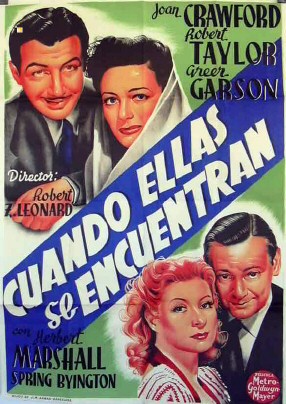
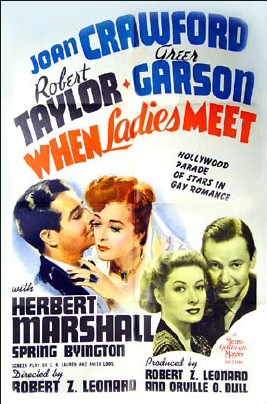
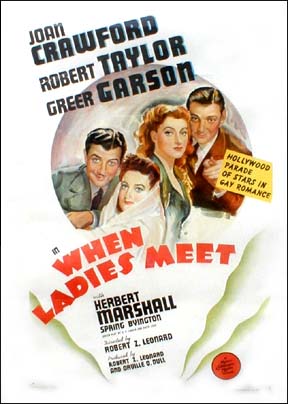

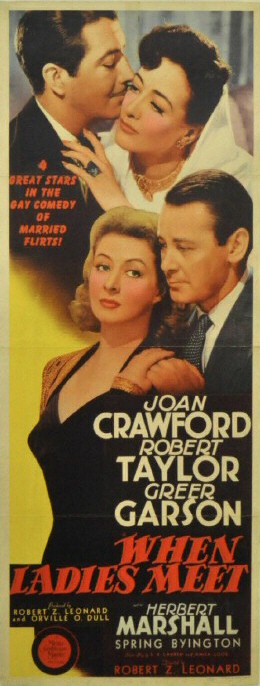
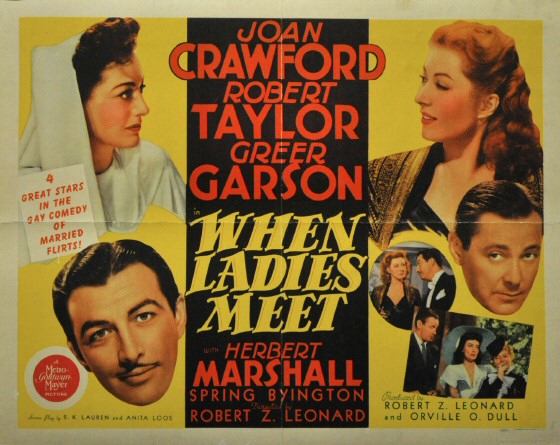
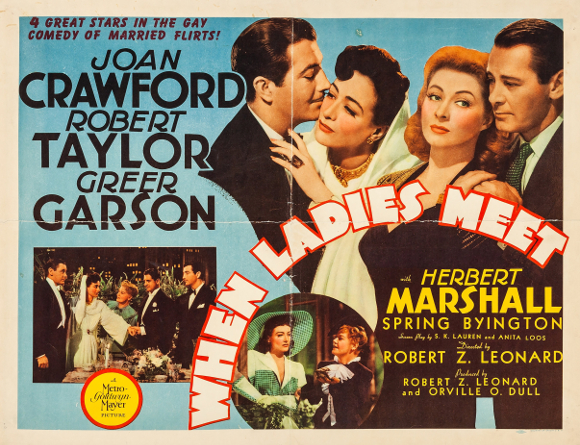


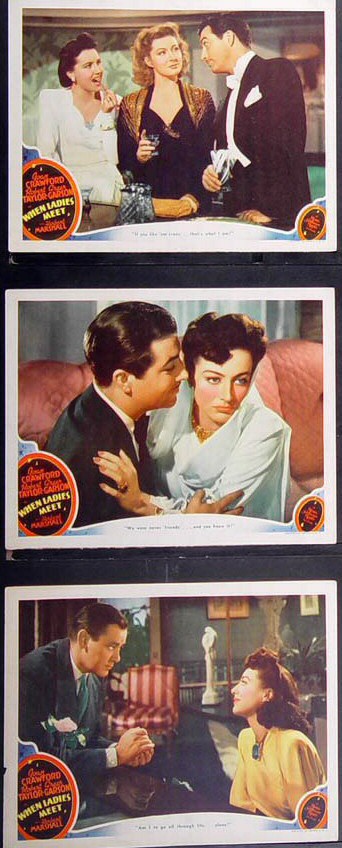

Above: US lobby cards
Below: Italian lobby cards
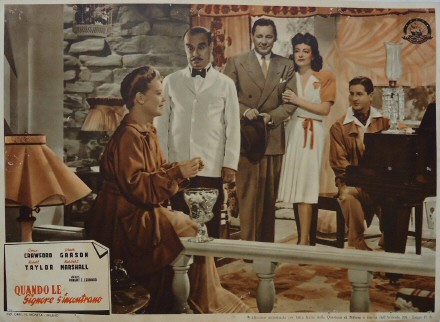
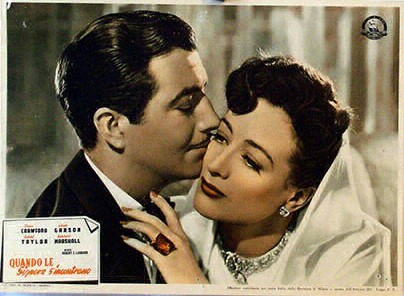
Below: Australian herald (11 x 6 inches)
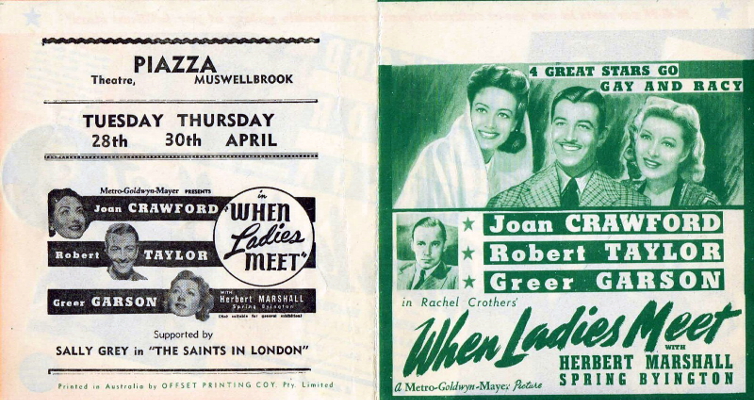
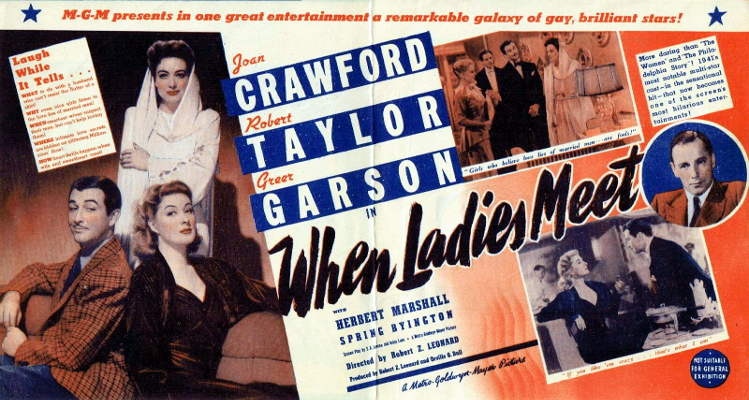
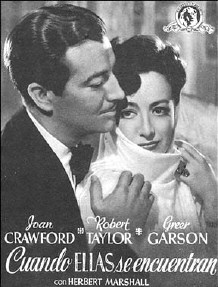
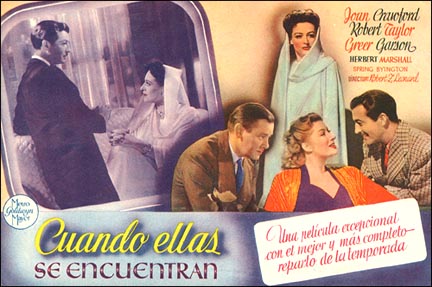
Above: Spanish herald.

Above: Window card from Indiana, USA.


Above: MGM trade ad with art by Jacques Kapralik.
The Best of Everything